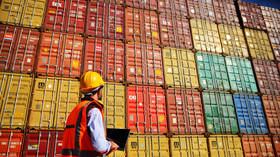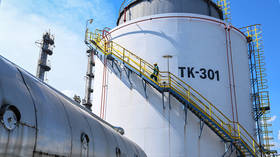Surge in EU exports to Russia

EU exports to Russia surged by 18% in June from the previous month, reaching €4.45 billion ($4.57 billion), foreign trade data from the statistics agency Eurostat shows.
This was the second consecutive month that exports to Russia rose, following the April low of just €2.78 billion. However, the value of goods shipped to Russia remains well below the June 2021 figure of €7.21 billion, as some 28% of EU exports to Russia remain under Ukraine-related sanctions.
In response to Russia’s military operation in Ukraine, Brussels banned the export to Russia from the EU of airplanes, bearings, dual-use technology, luxury goods, and other products. These restrictions delivered an instant blow to the bloc's exports to Russia, one of its largest trading partners in previous years.
Nevertheless, industrial equipment retained its position as the largest EU export to Russia, with June having seen shipments worth €1.12 billion, up 21% from May. The supply of medicines also increased, growing by 6% to €791 million over the previous month and surpassing last year’s figures by 31.5%. Medicine is now the second-largest EU export to Russia.
The bloc’s exports of perfumes and cosmetics, excluding luxury goods that exceed €300 per single item, rose in June by 38% to €108 million. Shipments of plastics and plastic products grew by 16% to €234 million, while deliveries of optical, measuring, control, medical devices and instruments and electrical equipment and components also jumped. However, exports in all of these categories remain well below last year’s levels.
Germany remains the largest EU exporter to Russia, with €1.16 billion worth of goods shipped in June, a 5.4% increase against May. Poland nearly doubled its shipments to Russia against April-May to €395 million, while exports from the Baltic states increased by 34% month-on-month, to €481 million.
Due to sanctions, the export of aircraft and aircraft components from Europe to Russia, which approached €3 billion in 2021, has dropped to zero since April 2022. Deliveries of cars and auto parts fell by more than ten times in annual terms and amounted to only €62 million in June.
Russia stopped publishing trade statistics shortly after the operation in Ukraine began. However, according to a report from the Bank of Russia in late July, citing data from Russia’s trading partners, the country’s overall imports of goods and services fell 22% in the second quarter of the year from the same time in 2021. Moscow repeatedly said that it will be able to overcome the impact of sanctions on imports, and that measures will be taken to substitute any missing goods with ones produced at home or obtained from other sources, such as China, Turkey and India.
In a draft of the directive on monetary policy published earlier this week, Russia's central bank predicted that despite the political pressure, imports would gradually recover.
“The pace of this recovery will be determined by the emergence of new financing and insurance mechanisms, the construction of new logistics routes and the formation of new trade relations. The mechanism of parallel imports, launched at the end of March, will also contribute to the growth of imports,” the regulator stated, as cited by the news agency RBC.
For more stories on economy & finance visit RT's business section














